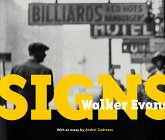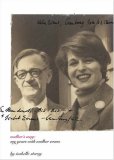
See larger photo
| Walker Evans: Signs
     
[Click on the appropriate flag to buy the book] | Product Details
Hardcover
96 pages
J Paul Getty Museum Pubns
Published 1998
Amazon.com
For many people, Walker Evans's name conjures up visions of the rural American South of the 1930s, where the photographer made some of his most notable images. But signs--marking buildings; advertising grocery prices, churches, and cabarets; communicating political messages--transfixed him throughout his life. Evans was interested in all aspects of signs, from the typography and graphic layout to the messages they conveyed and the objects themselves. He collected nearly as many of them as he photographed and often exhibited actual signs alongside his photos. Andrei Codrescu, in the essay he wrote to accompany the images in Signs, offers a concise explanation of the power of this subject matter. He writes that Evans's era was, "the time of popular writing, of huge advertisements, of lettering that invaded every nook and cranny and even wrote the skyline. America wrote big, with bold new alphabets, in lightbulbs, in neon, in smoke. One could follow the text of twentieth-century America from coast to coast...."
This small book is beautifully designed. The 50 gelatin silver prints selected from the Getty Museum's collection are reproduced on full pages with little or no cropping, and are meticulously documented at the back of the book with notations on dimensions, dates the photos were shot, and printing dates. A wide range of images, from the Photographer's Window Display, in which miniature portraits are displayed behind a pane of glass on which the word studio is painted, to a pair of commercially produced movie posters advertising a double feature of The Man from Guntown and I Hate Women, offers readers perspective on the breadth of Evans's vision. This focused look at an element of Evans's photography helps broaden the understanding of his entire body of work.
From Library Journal
These two books honoring the great American photographer Walker Evans differ in reproduction value and selection. Signs would be slight and disappointing without the excellent text by Romanian poet and National Public Radio commentator Codrescu. The unifying idea for this book?photos that represent Evans's lifelong affection for signs?feels original and yet ultimately limiting as you flip through marvelous black-and-white images like "Roadside Stand Near Birmingham" (1936) and "What, No... read more
Book Description
Walker Evans photographed signs throughout every phase of his career. From the 1920s to the time of his death in 1975, Evans was obsessed with the signage he found in modern America--from billboards to gas station pumps to street graffiti to handmade announcements of a Saturday-night dance. This book features fifth photographs of signs from the Getty Museum's collection, presented with a lively, provocative essay by Andrei Codrescu. Codrescu trains a perceptive eye on the artistic and social climate in Evans's America and reflects on the photographer's images as documents and commentary. Some of the images included come from the place and era most closely associated with Evans--the rural South of the 1930s. But also included are photographs that will be less familiar to many of his admirers, such as his images of New York City street scenes and advertising signs, or pictures he took in Havana and in Sarasota, Florida. |
Manuel Alvarez Bravo, Henri Cartier-Bresson, and Walker Evans.
Documentary and Anti-Graphic Photographs: A Reconstruction of the 1935 Exhibition at the Julien Levy Gallery in New York.
Alvarez Bravo (Photographer); Henri Cartier-Bresson (Photographer); Walker Evans (Photographer); Daniel Giradin (Essay); & Ian Jeffrey (Essay) |  |
|
Many Are Called
Walker Evans (Photographer) |  |
|
Walker Evans: Signs
Walker Evans (Photographer); Andrei Codrescu; & J. Paul Getty Museum |  |
|
Walker Evans: Cuba
Walker Evans (Photographer); Andrei Codrescu; & Judith Keller (Introduction) |  |
|
Incognito: Limited Edition
Walker Evans (Photographer); & Leslie Katz (Compiler) |  |
|
Walker Evans: Photographs for the Farm Security Administration, 1935-1938: A Catalog of Photographic Prints Available from the Farm Security Admini
Walker Evans (Photographer); & Library of Congress |  |
|
Walker Evans: Florida
Walker Evans (Photographer); & Robert Plunket |  |
|
|
Walker Evans: Polaroids
Walker Evans (Photographer); & Jeff L. Rosenheim |  |
|
Documenting America, 1935-1943 (Approaches to American Culture, No 2)
Carl Fleischhauer (Editor); Beverly W. Brannan (Editor); & Lawrence W. Levine (Editor) |  |
|
Walker Evans Simple Secrets: Photographs from the Collection of Marian and Benjamin A. Hill
Ellen Fleurov; Marian Hill; & High Museum Of Art |  |
|
|
|
American Photographers of the Depression: Walker Evans, Dorothea Lange and the FSA Photographers (Photofile)
Charles Hagen |  |
|
Walker Evans: American Photographs
Lincoln Kirstein; & Walker Evans (Photographer) |  |
|
Perfect Documents: Walker Evans and African Art, 1935
Virginia Lee-Webb; & Virginia-Lee Webb |  |
|
|
Walker Evans (Photofile)
Gilles Mora (Introduction); & Walker Evans (Photographer) |  |
|
|
Walker Evans: A Biography
Belinda Rathbone |  |
|
|
|
|
Walker Evans (Phaidon 55 S.)
Luc Sante; & Walker Evans |  |
|
Walker’s Way: My Years with Walker Evans
Isabelle Storey (Author) |  |
|
The Last Years of Walker Evans: A First-Hand Account
Jerry L. Thompson; & Walker Evans |  |
|
Reading American Photographs: Images As History: Mathew Brady to Walker Evans
Alan Trachtenberg |  |
| |

